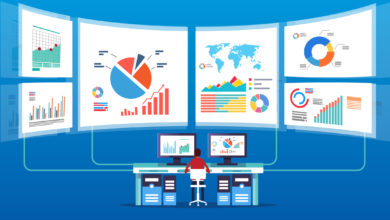[ad_1]
Digital Asset Management (DAM) is a central source of truth that allows organizations to easily store, organize, find, manage, distribute, and analyze their digital content.
Is your company having a hard time keeping up with your digital assets?
Stop me if you’ve heard any of these before:
-
Your video editor sends you a promotional video for a product launch slated for next month. You take the weekend off. On Monday morning, you look for the file. But you can’t remember the file name, much less the folder you put it in.
-
Your marketing team prepares a ton of marketing collateral to help your sales team achieve their goals, but you see little to no improvement because your sales reps keep using outdated content.
-
You’re a design manager, and you’re up to your neck in project briefs and deadlines. Instead of focusing on content creation, you’re wasting time responding to requests for creative files from your design team and other departments.
-
You’re working with a bunch of partners, distributors, sales teams, and retailers. But they’re either constantly bugging you for assets they can use in different formats, or they are using outdated or unapproved creative.
The list goes on.
All of these are solvable problems. A missing file can be sent and downloaded again. An image can be reformatted and resized in Photoshop in a matter of minutes. If something’s not clear, all you need to do is ask.
The problem? Doing all these requires more back and forth than your organization can afford. Minutes add up to hours and hours add up to days. The old adage still rings true: “Time is money!”
While many people hope that cloud storage tools like Dropbox would help solve this issue, in many cases they’ve only created a new set of problems. Duplicate files abound. Complicated folder structures become the norm.
Ask yourself this: if a new person joined your company today, how long would it take them to find a specific asset for a campaign? Would they have to ask someone? Is there a complicated naming structure they would have to understand to be able to effectively search for an asset?
There has to be a better way to manage all your assets.
Well, how’s this for a solution? Invest in a Digital Asset Management (DAM) system!
Since you’re reading this post, chances are you’ve at least heard of it.
The concept of Digital Asset Management sounds complicated at first. But it shouldn’t be. After all, it’s supposed to make life easier for you.
In this blog post, you’re going to learn what DAM is, what it does, and the many ways it can benefit your business.
But first, let’s talk about digital assets.
How does Duo Security save their creative team more than 10 hours per week with Brandfolder? Click here to watch the video.
What is a digital asset?
Digital assets are everywhere. Logos, product photos, brochures, images, videos, datasheets, newsletters — you name it. They’re all around us.
Which is a good thing, right? When you get right down to it, digital assets are the lifeblood of every business. They are critical to effective marketing, branding, and advertising.
Digital media is booming and it shows no signs of slowing down. However, this brave new world of digital transformation also poses numerous challenges for most of us.
In a world where digital media is constantly evolving, keeping up with the latest trends and innovations can be a challenge for most digital asset managers and businesses. It’s one thing to have a continually growing number library of digital media, but it’s another when you have to take into account multiple formats, channels, media files, product lines, and who knows what else.
This is where content chaos rears its ugly head. And it can easily overwhelm any organization that is ill-prepared to handle such a deluge of information.
As a marketer, creative, or business owner, it’s in your best interest to maximize the value of your digital content. To do that, you need to remove all the clutter and inefficiencies that get in the way.
This is where digital asset management (DAM) comes in.
What are the benefits of Digital Asset Management?
It’s important to think of digital asset management not only as a platform, but also as a process. After all, how can you organize and manage digital assets without a system to store and process all that information, including the metadata attached to them?
Simply put, DAM software is a solution that provides a secure central system that simplifies the storage, creation, management, production, deployment, and tracking of digital assets.
Put another way, a DAM system is like an enhanced digital media library that streamlines everything. It eliminates bottlenecks in the creative workflow, which can help boost productivity.
The 11 Benefits of Digital Asset Management
One of the most attractive benefits of digital asset management is that it gives your business, no matter the type, a professional and branded front. You might be a company of ten or ten thousand, but digital asset management will keep teams organized.
A DAM platform guarantees that you’re getting the most from your assets, and ensures you’re putting your best foot forward when you chat with the media, potential clients, or other external partners and key stakeholders.
Here are 11 more in-depth benefits of Digital Asset Management:
- Finds digital assets fast without any training
- Makes asset navigation simple and intuitive
- Helps avoid re-creating digital content that already exists
- Prevents digital assets from going unused
- Enables you to access and share files anytime, anywhere, on any device
- Helps you create and communicate digital assets from one place
- Makes it easy to distribute company content across multiple channels, including social media, third-party marketplaces, content management systems, and more
- Maintains brand consistency
- Identifies opportunities for repurposing digital assets
- Analyzes how assets are performing, where they’re being used, and who is using them
- Enhances knowledge management strategy and ability to turn tacit knowledge into explicit knowledge.
Brands today generate a lot more creative assets than they did ten years ago. Without a system to store, share, manage, and collaborate, you’re likely to experience asset sprawl and digital clutter. Click here to read our Digital Asset Management Maturity Guide. and see if the way your company is distributing assets is holding your team back.
Easy integration with Digital Asset Management
All systems are a go if you have a digital asset management platform.
This is because a DAM system can be integrated with a host of other tools and cloud-based platforms, including social media networks, content management systems, video solutions, and more.
DAM integrations centralize your core processes, allowing you to work with digital assets seamlessly, regardless of type, format, medium, storage location, or method of delivery.
Want to share your Adobe files with your development team? Simply drag and drop the files to the appropriate folder and forget about it. Want to receive real-time notifications every time an asset gets updated? A good DAM software has an integration for that, too.
You don’t need to waste time switching from one platform to another to find the right asset, or waste precious minutes downloading or uploading a single creative file in five different places. Moving files from one place to another is as quick and easy as adding a song to your favorite playlist.

Top Digital Asset Management Use Cases
Now that you have a general knowledge of what digital asset management is and the benefits, it’s time to get a little more in-depth about popular use cases. After all, there’s more value to DAM than meets the eye.
Digital Asset Management helps maintain brand consistency
Did you know that customers are more likely to purchase from a brand they recognize? It is for this reason that Fortune 500 companies make a proactive effort to maintain brand consistency in their marketing and advertising campaigns.
This makes perfect sense. For one thing, 87% of buyers prefer brands that provide consistent customer experience across all channels.
Is it any wonder why Nike’s “Just Do It” campaign was so successful over the past few decades? They killed the competition not only because of their simple but powerful slogan, but also because of their remarkable consistency. Every ad, every poster, every piece of marketing collateral screams “Just Do It.” Today, Nike remains one of the most recognizable brands in the world.
When the assets you bring into the world are anchored by your brand’s core values and identity, your target audience is more likely to pay attention. A sudden shift in color motif, or a tagline or slogan that slightly deviates from your brand’s core principles, is more than enough to compel potential customers to look somewhere else.
Brand management becomes a cinch when you have a DAM solution that serves as a central repository for your digital content. Relevant and up-to-date digital or media files become readily accessible, making it easier for users to create, manage, share, and use assets and rich media in ways that are in line with your brand guidelines.
Digital Asset Management improves analytics and delivers insights
This is another area where a digital asset management solution can help. Thanks to a DAM software’s integration capabilities, you can get a bird’s eye view of all data around the use of your digital assets.
Whether you’re tracking response rates, conversion rates, engagement rates, number of shares, and other metrics, a central repository for all your platforms and analytics tools can help give you a more accurate picture of your ROI as it relates to your assets.
In other words, a DAM solution makes it easier to gather, manage, and interpret data from multiple sources, giving you valuable insights on how to maximize the use of your digital assets in accordance with your business goals.

Digital Asset Management keeps content secure, and more
It goes without saying: you need to keep your assets secure all the time. After all, files get corrupted. Servers crash and fail. Files get lost due to mismanagement.
Implementing a DAM software eliminates all these risks because it stores and secures all your digital assets in the cloud. This is a step in the right direction. Why? Because cloud-based DAM systems come with features like versioning control, rights management, artificial intelligence (AI), data rendering, and more.
In other words, a DAM platform goes beyond the basics of cloud storage.
Digital Asset Management improves collaboration
A digital asset management solution creates an environment built for collaboration. When your creative teams use a file sharing platform that serves as a “central source of truth,” it’s easy for everyone to be on the same page, regardless of their location, time zone, language, or the department they belong to.
Because digital asset management solutions allow you to define role hierarchies and user permissions across all workflows, each user is able to understand his or her role better, propelling them to work on assigned tasks with laser focus.
Digital Asset Management enables users to find assets faster
Finding a specific digital asset can be even more time-consuming, not to mention frustrating, when you have files stored across different platforms and folders.
In fact, employees without access to a DAM system spend five times longer looking for the right assets.
DAM software uses metadata to quickly find “lost” digital or media files with minimal effort. Even tangential search terms can help you find what you’re looking for if the asset concerned has rich amounts of metadata.
Combine that with a DAM software’s intuitive visual interface and streamlined folder structure, and all of your digital assets are at your fingertips.
Digital Asset Management speeds up time-to-market
As market trends evolve and new technologies emerge, businesses are finding it harder to meet and exceed customer expectations. A digital asset management system allows businesses to keep up with these changes.
Thanks to its integration capabilities, intuitive interface, collaborative environment, and streamlined processes, a DAM software can help you thrive in a multi-channel environment. It speeds up your organization’s ability to execute campaigns, from ideation to development to execution.
Digital Asset Management eliminates risk of license non-compliance
Most digital or media assets can be obtained for free, but the really good ones have licensing agreements attached to them. It gets difficult to keep tabs with these agreements when you have a massive database of photos, audio files, videos, and logos to keep tabs on.
Non-compliance to such agreements not only make you liable to pay fines, but it can also tarnish your brand’s reputation. Many organizations have closed up shop due to negative press and you don’t want your organization to suffer the same fate.
Keeping track of your compliance obligations is critical to your organization’s survival, but it requires a lot of time and effort that could otherwise be spent on core business activities.
Digital Asset Management systems come with a digital rights management (DRM) feature that ensures all copyright information is up-to-date and that all licensing agreements are upheld all the time. Thanks to DAM, staying compliant to licensing agreements requires little to no effort.
See how P.F. Chang’s global marketing team is able to manage their digital assets at scale and save hours of work each month. Click here to watch the video.
Are you ready for a Digital Asset Management solution?
Now that you’ve reached this far into the article, it should be pretty clear to you whether your organization can benefit from a DAM solution or not.
If you value your digital assets and believe they are essential to the success of your business, then the answer should be obvious.
Are you ready to take control of your assets?
Source link







